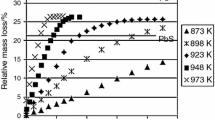Summary
From the results described in this paper, it may be concluded that the precipitation of zinc from the solution of zinc sulphate is complete with a quantity of alkali which is much below the theoretically equivalent amount. The effect of temperature and dilution is not very marked as was observed in the precipitation of several metal hydroxides studied by us (5). From the adsorption studies we find that the association of sulphate with the precipitated hydroxides decreases with the increase in the concentration of alkali employed. As long as the precipitation of zinc is not complete, no generalization is possible on account of unequal amounts of adsorbent hut when the precipitation is complete a regularity in adsorption is noted. With increase in temperature, from 30° to 50° the adsorption of sulphate decreases in every case but with further rise in temperature, hydrolysis appears to be taking place, with time, and hence the amount of sulphate associated again increases. These observations are in accordance with those made in earlier studies. This paper records some of the preliminary observations and full work is in progress to understand the character of zinc hydroxide more fully.
Zusammenfassung
Zur vollständigen Fällung von Zink aus dessen Sulfatlösung reicht eine weit geringere Menge Alkali aus, als es der theoretisch äquivalenten entspräche. Temperaturänderungen und Konzentrationsänderungen wirken sich im vorliegenden Falle nicht annähernd so stark aus wie bei der Fällung verschiedener anderer Metallhydroxyde (5). Die Sulfat-Assoziation an den Hydroxydniederschlag nimmt mit steigenden zur Fällung desselben verwendeten Alkalikonzentrationen ab. Bei unvollständiger Fällung läßt sich keine Aussage über adsorbierte Ionenkonzentrationen machen, sichere dagegen bei vollständiger Fällung. Die Sulfatadsorption geht mit steigender Temperatur zurück. Oberhalb 50° C nimmt sie aber erneut wieder zu, da dann wahrscheinlich Hydrolyse einsetzt. Die hier mitgeteilten Ergebnisse sind in Übereinstimmung mit unseren früheren Arbeiten. Sie sollen durch weitere Untersuchungen ergänzt werden.
Similar content being viewed by others
Literatur
Britton, Annual Reports, Chemical Soc., London,40, 43 (1943).
Weiser, Inorganic Colloid Chemistry, Vol. 2 (New York 1935).
Fricke und Hüttig, Hydroxyde und Oxyhydrate (Leipzig 1937).
Heubel, Ann. Chem.4, 699 (1949).
Kulshrestha, Dey und Gosh, Kolloid-Z.132, 143 (1953).
Deshapande und Kabadi, J. Univ. Bombay,1943.
Cone und Cady, J. Amer. Chem. Soc.49, 356 (1927).
Vogel, Quantitative Inorganic Analysis (London).
Author information
Authors and Affiliations
Additional information
Übersetzt von Dr. K. Jäckel, Marburg/Lahn.
Rights and permissions
About this article
Cite this article
Varshney, K.C., Dey, A.K. & Ghosh, S. Über die Fällung wäßrigen Oxydes aus einer Zinksulfatlösung I. Kolloid-Zeitschrift 141, 40–42 (1955). https://doi.org/10.1007/BF01511750
Received:
Issue Date:
DOI: https://doi.org/10.1007/BF01511750



